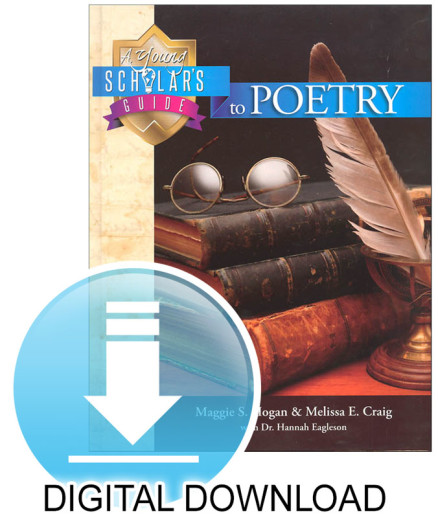We use cookies to make your experience better. To comply with the new e-Privacy directive, we need to ask for your consent to set the cookies. Learn more.
Young Scholar's Guide to Poetry Digital Download
e-book (not print version). Product is entirely digital.
When you look at a poem, what do you see? When you listen to a poem, what do you hear? When you write a poem, what picture do you create?
Poetry is the art of carefully selecting and shaping words to paint a picture or create a feeling. Throughout the history of the world, poets have offered us a moving understanding of humanity.
Why take time to piece together the poetry puzzle Because the Bible is full of poetry and imagery, learning about poetry helps us understand God’s Word. Working with poetry helps us better understand the English language. Writing poetry offers a unique way to express our thoughts and feelings. Exploring poetry joins us with our past in the aha moment when we recognize a truth that someone else has put to words.
This course provides a close-up look at poets through the ages and provides the opportunity to interact with their work. By exploring a range of poetic techniques & devices, students will be able to both read and create poetry with understanding and meaning. The authors walk incrementally with young writers through the process of composing their own poetry and encourage their individual creativity.
Includes 32 weekly lessons covering biographies of famous poets and explanations of key poetic devices, easy-to-use timeline and maps, poet info-cards and game directions, poetic device cards, poetry puzzle cards, student reviews, answer keys, coloring pages, poetry reading and resource list, and more.
Through a broad selection of ancient, classical, Biblical and modern poetry, this guide introduces this symbolic world as appealing, accessible and understandable to anyone. Each poetic device is taught by highlighting a unique poem and its poet. Activities like timelines, puzzles, games, and poetry journals reinforce learning. At each unit's end, students review all previous concepts and then practice the devices learned. Unit 1 teaches structure and rhyme scheme (including various rhymed lines, shaped, villanelle, free verse, and sonnets). Unit 2 covers epic, ode, ballad, pastoral devotional, narrative, and 3 types of humorous poems. Unit 3 teaches anaphora, refrain, rhyme, consonance, alliteration, onomatopoeia, symbolism, personification, apostrophe, metaphor and simile. The free digital Companion Guide on the publisher's website includes reproducible student reviews, coloring pages, game templates and a lesson text work space (rather than writing in the text), and the text answer key. 8 ½"x 11 ¼". 255 pgs, hc.
| Product Format: | Other |
|---|---|
| Brand: | Bright Ideas Press |
| Grades: | 4-8 |

